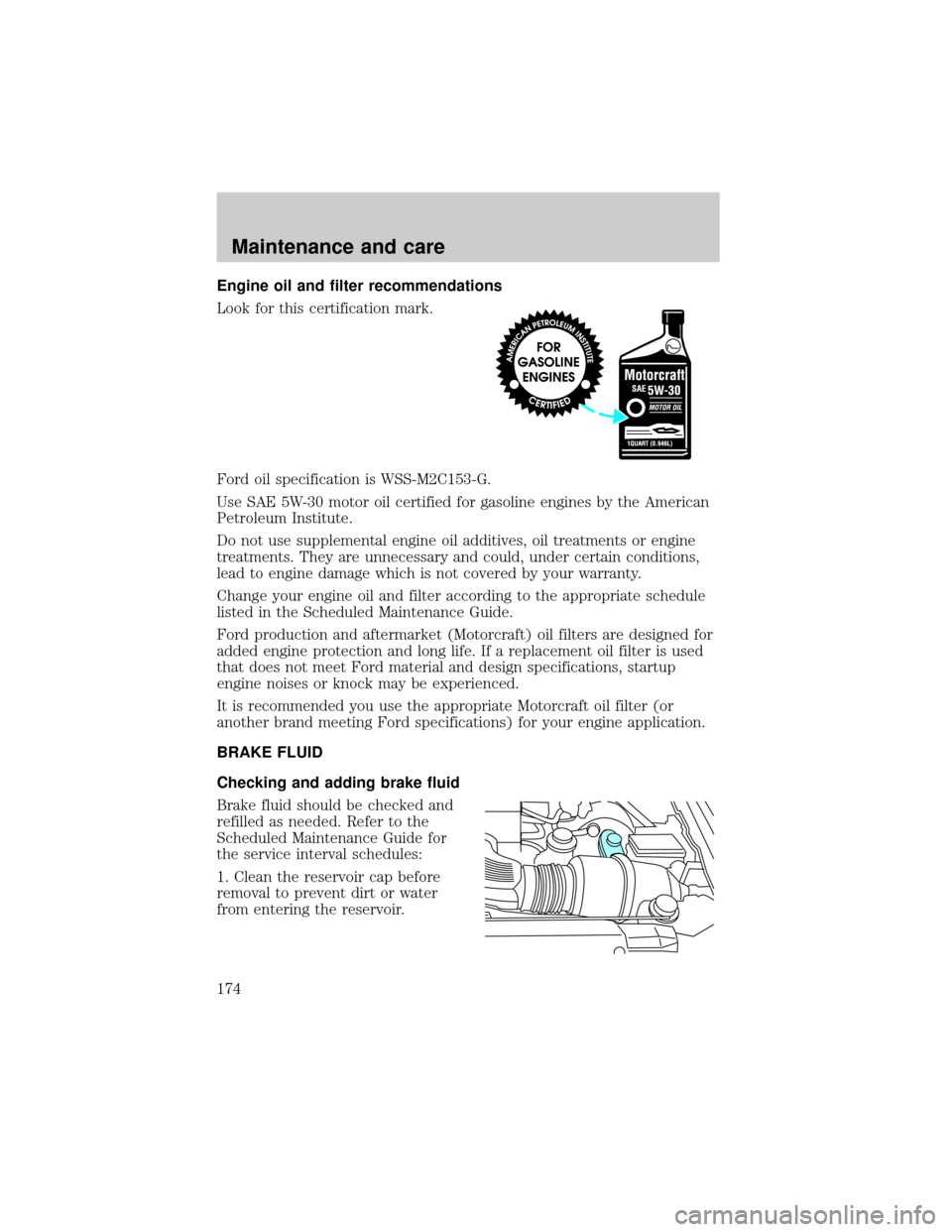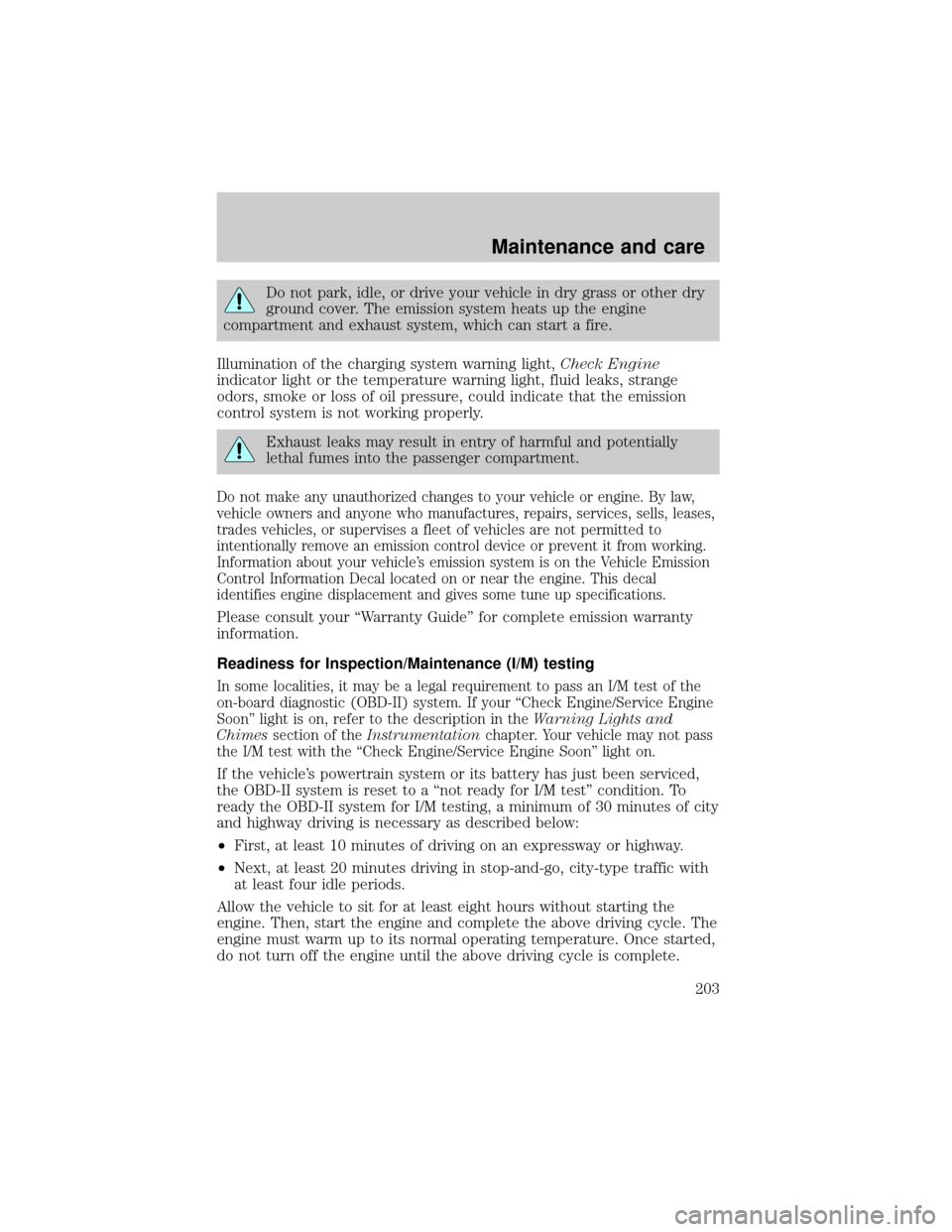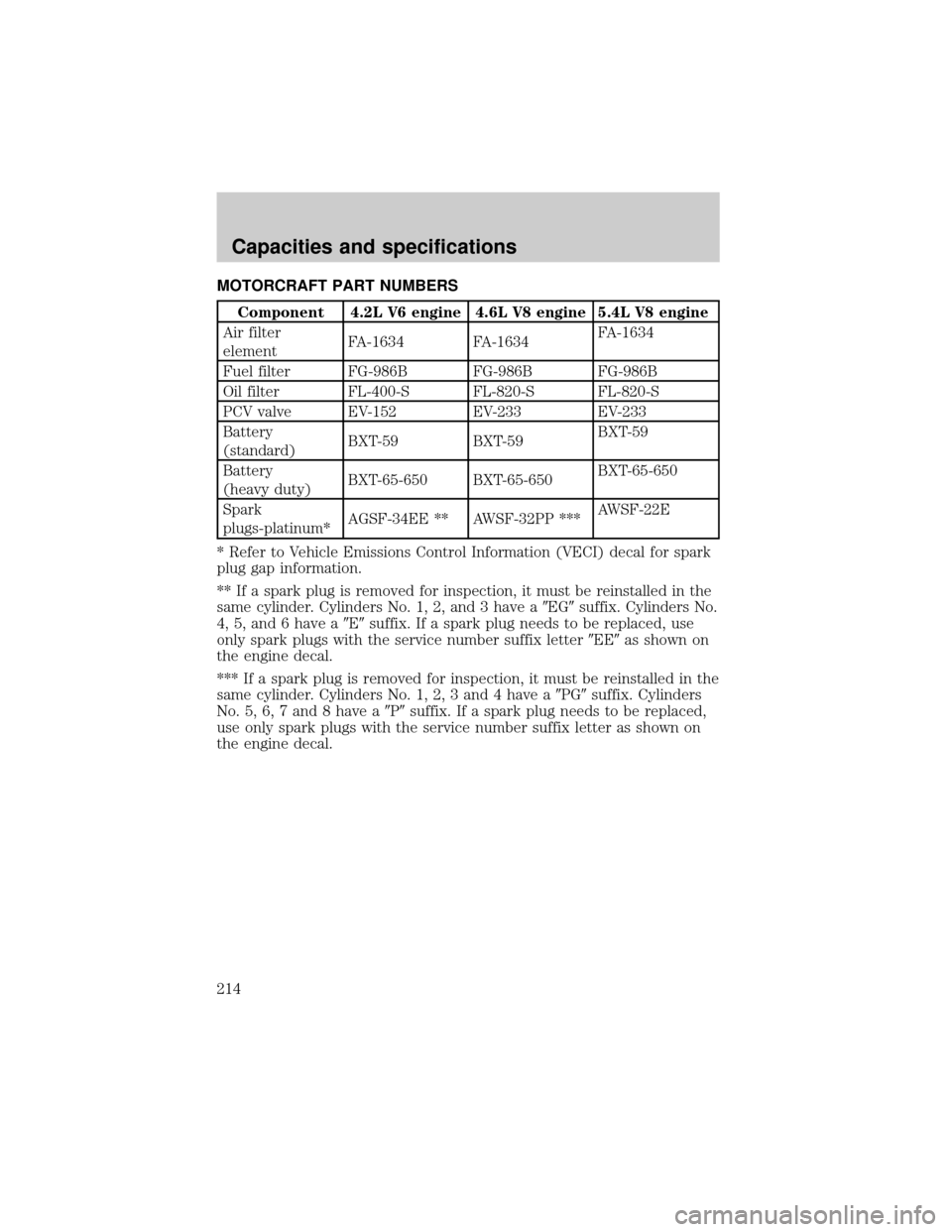Page 173 of 232
²If the oil level is below the MIN
mark, add enough oil to raise the
level within the MIN-MAX range.
²Oil levels above the MAX mark may cause engine damage. Some oil
must be removed from the engine by a service technician.
7. Put the indicator back in and ensure it is fully seated.
Adding engine oil
1. Check the engine oil. For instructions, refer toChecking the engine
oilin this chapter.
2. If the engine oil level is not within the MIN and MAX ranges, add only
certified engine oil of the recommended viscosity. Remove the engine oil
filler cap and use a funnel to pour the engine oil into the opening.
3. Recheck the engine oil level. Make sure the oil level is not above the
MAX mark on the dipstick.
Maintenance and care
173
Page 174 of 232

Engine oil and filter recommendations
Look for this certification mark.
Ford oil specification is WSS-M2C153-G.
Use SAE 5W-30 motor oil certified for gasoline engines by the American
Petroleum Institute.
Do not use supplemental engine oil additives, oil treatments or engine
treatments. They are unnecessary and could, under certain conditions,
lead to engine damage which is not covered by your warranty.
Change your engine oil and filter according to the appropriate schedule
listed in the Scheduled Maintenance Guide.
Ford production and aftermarket (Motorcraft) oil filters are designed for
added engine protection and long life. If a replacement oil filter is used
that does not meet Ford material and design specifications, startup
engine noises or knock may be experienced.
It is recommended you use the appropriate Motorcraft oil filter (or
another brand meeting Ford specifications) for your engine application.
BRAKE FLUID
Checking and adding brake fluid
Brake fluid should be checked and
refilled as needed. Refer to the
Scheduled Maintenance Guide for
the service interval schedules:
1. Clean the reservoir cap before
removal to prevent dirt or water
from entering the reservoir.
Maintenance and care
174
Page 201 of 232
![FORD F150 1999 10.G Owners Manual ²Drive at reasonable speeds (traveling at 105 km /h [65 mph] uses 15%
more fuel than traveling at 88 km/h [55 mph]).
²Revving the engine before turning it off may reduce fuel economy.
²Use of the a FORD F150 1999 10.G Owners Manual ²Drive at reasonable speeds (traveling at 105 km /h [65 mph] uses 15%
more fuel than traveling at 88 km/h [55 mph]).
²Revving the engine before turning it off may reduce fuel economy.
²Use of the a](/manual-img/11/5018/w960_5018-200.png)
²Drive at reasonable speeds (traveling at 105 km /h [65 mph] uses 15%
more fuel than traveling at 88 km/h [55 mph]).
²Revving the engine before turning it off may reduce fuel economy.
²Use of the air conditioner or defroster may reduce fuel economy.
²Use of speed control (if equipped) may improve fuel economy. Speed
control can help maintain a constant speed and reduce speed changes.
You may want to turn off the speed control in hilly terrain as
unnecessary shifting between third and fourth gears may occur and
could result in reduced fuel economy.
²Warming up a vehicle on cold mornings is not required and may
reduce fuel economy.
²Resting your foot on the brake pedal while driving may reduce fuel
economy.
²Combine errands and minimize stop-and-go driving.
Maintenance
²Keep tires properly inflated and use only recommended size.
²Operating a vehicle with the wheels out of alignment will reduce fuel
economy.
²Use recommended engine oil. Refer toLubricant Specifications.
²Perform all regularly scheduled maintenance items. Follow the
recommended maintenance schedule and owner maintenance checks
found in your vehicle Scheduled Maintenance Guide.
Conditions
²Heavily loading a vehicle or towing a trailer may reduce fuel economy
at any speed.
²Carrying unnecessary weight may reduce fuel economy (approximately
2 km/h [1 mpg] is lost for every 180 kg [400 lb] of weight carried).
²Adding certain accessories to your vehicle (for example bug
deflectors, rollover/light bars, running boards, ski/luggage racks) may
reduce fuel economy.
²To maximize the fuel economy, drive with the tonneau cover installed
(if equipped).
²Use of fuel blended with alcohol may lower fuel economy.
Maintenance and care
201
Page 203 of 232

Do not park, idle, or drive your vehicle in dry grass or other dry
ground cover. The emission system heats up the engine
compartment and exhaust system, which can start a fire.
Illumination of the charging system warning light,Check Engine
indicator light or the temperature warning light, fluid leaks, strange
odors, smoke or loss of oil pressure, could indicate that the emission
control system is not working properly.
Exhaust leaks may result in entry of harmful and potentially
lethal fumes into the passenger compartment.
Do not make any unauthorized changes to your vehicle or engine. By law,
vehicle owners and anyone who manufactures, repairs, services, sells, leases,
trades vehicles, or supervises a fleet of vehicles are not permitted to
intentionally remove an emission control device or prevent it from working.
Information about your vehicle's emission system is on the Vehicle Emission
Control Information Decal located on or near the engine. This decal
identifies engine displacement and gives some tune up specifications.
Please consult your ªWarranty Guideº for complete emission warranty
information.
Readiness for Inspection/Maintenance (I/M) testing
In some localities, it may be a legal requirement to pass an I/M test of the
on-board diagnostic (OBD-II) system. If your ªCheck Engine/Service Engine
Soonº light is on, refer to the description in theWarning Lights and
Chimessection of theInstrumentationchapter. Your vehicle may not pass
the I/M test with the ªCheck Engine/Service Engine Soonº light on.
If the vehicle's powertrain system or its battery has just been serviced,
the OBD-II system is reset to a ªnot ready for I/M testº condition. To
ready the OBD-II system for I/M testing, a minimum of 30 minutes of city
and highway driving is necessary as described below:
²First, at least 10 minutes of driving on an expressway or highway.
²Next, at least 20 minutes driving in stop-and-go, city-type traffic with
at least four idle periods.
Allow the vehicle to sit for at least eight hours without starting the
engine. Then, start the engine and complete the above driving cycle. The
engine must warm up to its normal operating temperature. Once started,
do not turn off the engine until the above driving cycle is complete.
Maintenance and care
203
Page 214 of 232

MOTORCRAFT PART NUMBERS
Component 4.2L V6 engine 4.6L V8 engine 5.4L V8 engine
Air filter
elementFA-1634 FA-1634FA-1634
Fuel filter FG-986B FG-986B FG-986B
Oil filter FL-400-S FL-820-S FL-820-S
PCV valve EV-152 EV-233 EV-233
Battery
(standard)BXT-59 BXT-59BXT-59
Battery
(heavy duty)BXT-65-650 BXT-65-650BXT-65-650
Spark
plugs-platinum*AGSF-34EE ** AWSF-32PP ***AWSF-22E
* Refer to Vehicle Emissions Control Information (VECI) decal for spark
plug gap information.
** If a spark plug is removed for inspection, it must be reinstalled in the
same cylinder. Cylinders No. 1, 2, and 3 have a9EG9suffix. Cylinders No.
4, 5, and 6 have a9E9suffix. If a spark plug needs to be replaced, use
only spark plugs with the service number suffix letter9EE9as shown on
the engine decal.
*** If a spark plug is removed for inspection, it must be reinstalled in the
same cylinder. Cylinders No. 1, 2, 3 and 4 have a9PG9suffix. Cylinders
No. 5, 6, 7 and 8 have a9P9suffix. If a spark plug needs to be replaced,
use only spark plugs with the service number suffix letter as shown on
the engine decal.
Capacities and specifications
214
Page 215 of 232
REFILL CAPACITIES
FluidFord Part
NameApplication Capacity
Brake fluidHigh
Performance
DOT 3
Motor
Vehicle
Brake FluidAll Fill to line on
reservoir
Engine
coolant
1
Premium
Engine
Coolant4.2L V6 engine with
1 row radiator19.0L (20.1 quarts)
4.2L V6 engine with
2 row radiator20.4L (21.6 quarts)
4.6L V8 engine with
1 row radiator19.5L (20.6 quarts)
4.6L V8 engine with
2 row radiator21.9L (23.1 quarts)
5.4L V8 engine with
1 row radiator22.6L (23.9 quarts)
5.4L V8 engine with
2 row radiator24.1L (25.5 quarts)
Engine oil
(includes
filter
change)Motorcraft
5W30 Super
Premium
Motor OilAll 5.7L (6.0 quarts)
Fuel tank N/A4x4 Reg. Cab short
wheelbase92.7L (24.5 gallons)
4x2 Regular Cab
and all SuperCab
short wheelbase94.6L (25.0 gallons)
Long Wheelbase 113.6L (30.0 gallons)
Power
steering
fluidMotorcraft
MERCONt
AT FAll Fill to line on
reservoir
Transfer
case fluid
2
Motorcraft
MERCONt
AT F4x4 vehicles 1.9L (2.0 quarts)
Capacities and specifications
215
Page 218 of 232
ItemFord part
name or
equivalentFord part
numberFord
specification
Engine coolant Ford Premium
Engine CoolantE2FZ-19549-AA
(in Oregon,
F5FZ-19549-CC,
in Canada,
Motorcraft
CXC-10)ESE-M97B44-A
Engine oilMotorcraft 5W30
Super Premium
Motor OilXO-5W30-QSP WSS-M2C153-G
and API
Certification
Mark
Hinges, latches,
striker plates,
fuel filler door
hinge and seat
tracks.Multi-Purpose
GreaseDOAZ-19584-AA
or
F5AZ-19G209-AAESB-M1C93-B or
ESB-M1C159-A
Transmission
/steering/parking
brake linkages
and pivots,
brake and clutch
pedal shaft (if
equipped)Premium
Long-Life GreaseXG-1-C ESA-M1C75-B
Power steering
fluid, transfer
case fluid (4X4)
and transmission
fluid (manual)Motorcraft
MERCONtAT FXT-2-BDX or
QDXMERCONt
Automatic
transmission
(4R100)
2
Motorcraft
MERCONtAT FXT-2-BDX or
QDXMERCONt
Automatic
transmission
(4R70W)Motorcraft
MERCONtV
AT FXT-5-QM
MERCONtV
Windshield
washer fluidUltra-clear
windshield
washer
concentrateC9AZ-19550-AC ESR-M17P5-A
Capacities and specifications
218
Page 219 of 232

1Add 118 ml (4 oz.) of additive friction modifier C8AZ-19B546±A, Ford
specification EST-M2C118±A for complete refill of 8.8 inch and 9.75 inch
Traction-Lok axles. Add 236 ml (8 oz.) of additive friction modifier
C8AZ-19B546±A, Ford specification EST-M2C118±A for complete refill of
10.25 and 10.5 inch Traction-Lok axles.
2Refer to the dipstick for the type of transmission fluid required. Some
fluid labels may indicate dual usage such as MERCONtand MERCON
Vt. These dual usage fluids are not to be used in transmissions that use
only the MERCONttype fluid. These dual usage fluids may be used in
transmissions that require MERCONtV use.
Using a transmission fluid that indicates a dual usage (MERCONtand
MERCON Vt) in a transmission application requiring MERCONtmay
cause transmission damage. Use of any fluid other than the
recommended fluid may cause transmission damage.
ENGINE DATA
Engine 4.2L V6 engine 4.6L V8 engine 5.4L V8 engine
Cubic inches 256 281 330
Horsepower205 @ 4750 rpm 220 @ 4500
rpm
1250 @ 4500 rpm
Torque250 lb.-ft. @
3000 rpm290 lb.-ft. @
3250 rpm345 lb.-ft. @
2250 rpm
Recommended
fuel87 octane 87 octane 87 octane
Firing order 1-4-2-5-3-6 1-3-7-2-6-5-4-8 1-3-7-2-6-5-4-8
Spark plug gap1.3-1.4 mm
(0.052-0.056
inch)1.3-1.4 mm
(0.052-0.056
inch)1.3-1.4 mm
(0.052-0.056
inch)
Ignition system EDIS EDIS Coil on plug
Compression
ratio9.3:1 9.0:1 9.0:1
1All F150 vehicles and F250 with manual transmission. F250 with
automatic transmission is 235 hp @ 4400 rpm.
Capacities and specifications
219